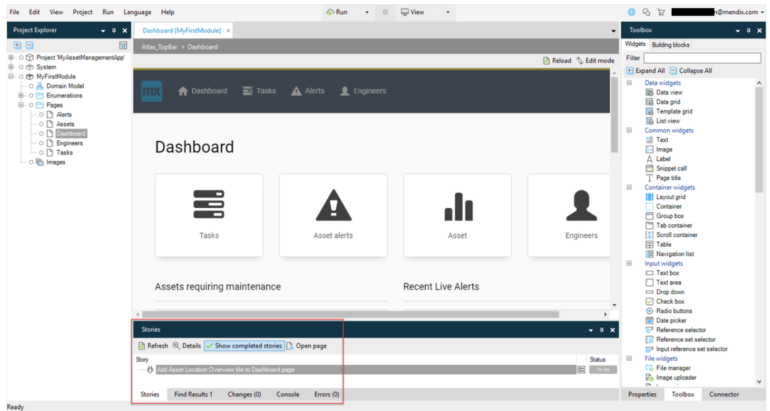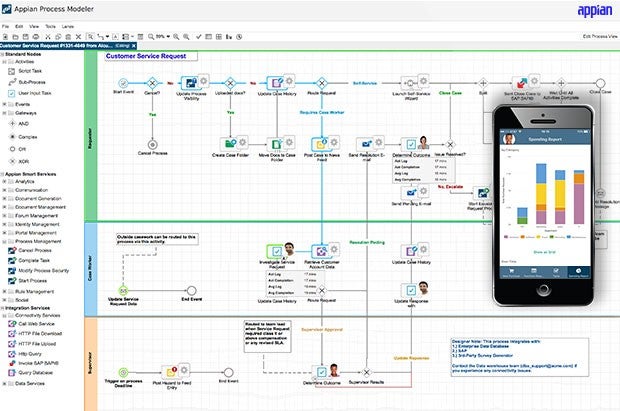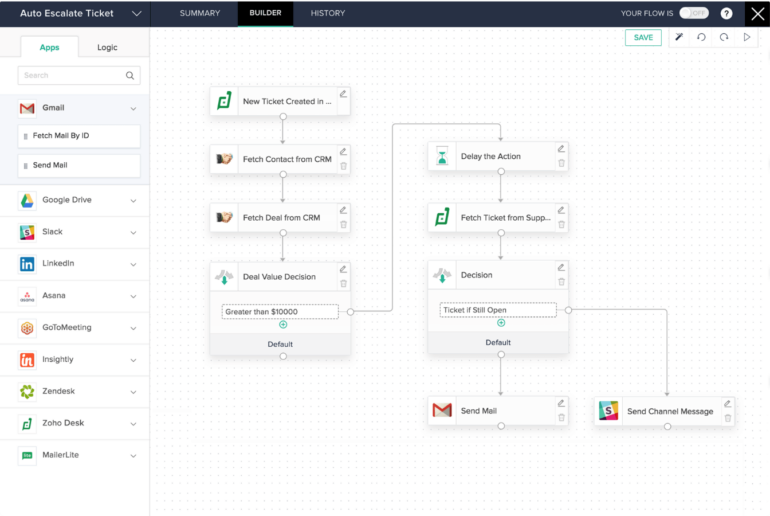Low-code or no-code development platforms let users convert ideas into apps without the need for extensive coding knowledge or experience. Beyond being user-friendly and minimizing the need for technical know-how, these platforms help developers build apps quickly, stay compliant and minimize costs and mistakes. This guide will break down the following top low-code platforms for developers in terms of their features, pros, cons and pricing:
- Mendix: A solid pick for developers needing a user-friendly, flexible and scalable low-code platform that minimizes the need for manual coding via a visual interface and pre-built blocks.
- Appian: Ideal for developers looking for a scalable, reliable and secure low-code automation platform to optimize processes, automate tasks and quickly build apps.
- Zoho Creator: A great choice for developers seeking a low-code platform that offers easy drag-and-drop functionality, automation and hundreds of pre-built integrations.
Jump to:
Mendix
Mendix is an award-winning low-code application development platform that provides a visual interface and pre-built components to minimize the need for programming skills when building apps.
Features of Mendix

Mendix’s long list of features is highlighted by:
- Integrated development environment for all skill levels.
- Artificial intelligence and machine learning.
- Team collaboration.
- Deployment flexibility.
- Extensibility.
- Mendix Connect.
- Security and governance.
Mendix provides an IDE that users of all skill levels can access to start building applications. The IDE offers customization to fit your needs, collaboration via Git-based version control, automated testing and debugging, light and dark modes and more. Developers can build smart apps and streamline processes via the low-code platforms’ enhanced AI and ML capabilities that include co-developer bots (MxAssist) and the Mendix ML Kit.
Software development teams can collaborate with the Feedback Management Model, Agile project management tools (Scrum and Kanban boards), and project spaces with DevOps and backlog management capabilities. Developers can deploy wherever they wish (on-premises or private/public/hybrid clouds) and extend Mendix via third-party integrations. The Mendix Connect feature ensures data consistency, and the developer tool promotes security and governance with access controls, custom DevOps and more.
SEE: Best Devops automation tools
Pros of Mendix
Mendix’s advantages include:
- Easy to use.
- Team collaboration.
- Free plan.
- Extensibility.
Even non-technical users will likely find Mendix user-friendly, easy to learn and intuitive.
Software development teams get several avenues for collaboration from the programmer tool, and the free plan gives smaller teams and individuals a chance to start building apps via the low-code platform at no cost. Another Mendix advantage is its extensibility and the power to integrate with test automation tools, CI/CD pipelines and more.
Cons of Mendix
Mendix’s disadvantages include:
- Costly premium plans.
- Limited documentation.
- Customer support.
While Mendix’s Free plan is a nice option for those with limited budgets, the low-code platform can get quite pricey once you jump into its premium plans. More detailed documentation and resources would be useful, and Mendix’s customer support could use some improvement.
Pricing of Mendix
Mendix offers pricing plans for software development teams of all sizes. If you want to build just one app, Mendix’s pricing plans are as follows:
- Free: No cost for those looking to try the low-code platform.
- Basic: Starts at $60 per month.
- Standard: Starts at $950 per month.
- Premium: Custom pricing.
If you want to build unlimited apps, Mendix’s pricing plans are as follows:
- Free: No cost.
- Standard: Starts at $2,375 per month.
- Premium: Custom pricing.
The Free plan offers Agile project management, no-code/citizen development, low-code/pro development, two environments per app and community support. The Basic plan (for one app build only) adds business-hour support and a 99.5% uptime guarantee, while the Standard plan includes a project dashboard, four environments per app, an ops dashboard, IDP integration and a customer success manager. Mendix’s Premium plan includes a private marketplace, horizontal scalability, advanced infrastructure control and 24/7 support.
Appian
Appian is a secure, reliable and scalable low-code automation platform that helps businesses optimize processes, automate tasks, improve efficiency and rapidly build applications.
Features of Appian

Appian’s low-code feature highlights include:
- Visual design tools.
- Template library.
- Team collaboration.
- Automation.
- Multi-device support.
- Data integration.
Appian’s visual design tools with drag-and-drop functionality help developers build robust apps and workflows up to 90% faster than manual coding. Such speed is supported via pre-built UI frameworks and templates; team collaboration features like group security, shared package linking, and document comparison; and time-saving automation with IDP and RPA capabilities. Once an app is built, Appian ensures its appearance and performance are optimized across all operating systems and devices, saving you time on development and deployment.
Appian eliminates the need for time-consuming data migration and supports low-code/no-code integrations for Salesforce, relational database management systems, Microsoft Dynamics and more. The developer tool also simplifies scaling with one-click deployment, automated unit and UI tests, performance and resource usage monitoring, high availability and Appian Cloud.
Pros of Appian
Appian’s strengths include:
- Easy to learn.
- Clean interface.
- Speedy deployment.
- Access control.
As most low-code platforms intend to be, Appian is easy to learn and lets you start building apps rather quickly without coding experience. Part of this is due to the clean and intuitive interface. The developer tool not only accelerates the app-building process but also leads to fast deployment. Appian also excels in its access control that enhances security and offers flexibility in opening doors to users with differing roles.
Cons of Appian
Appian’s weaknesses include:
- Pricing.
- UI customization.
- Documentation.
Appian may seem costly for small and medium-sized development teams. While easy to navigate, the user interface lacks customization. Documentation could also be improved.
Pricing of Appian
Appian has four pricing plans to choose from:
- Free: Appian Community Edition.
- Application: Input-Only costs $2; Infrequent costs $9; and Standard costs $75 (all per user per month).
- Platform: Custom pricing per user with unlimited apps.
- Unlimited: Custom pricing per development with unlimited apps.
Appian’s Free plan serves up to 15 users. It includes cloud deployment, community support, process mining and complete automation (robotic process automation, business rules, AI, smart services and intelligent document processing). The fully featured Application and Platform plans offer advanced support and Appian Cloud, high availability cloud, public cloud and self-managed or hybrid deployment. The Unlimited plan offers the same, but for unlimited users.
Zoho Creator
Zoho Creator is a low-code application development platform that lets developers convert ideas into apps visually via simple drag-and-drop functionality. The developer tool has hundreds of pre-built integrations for extensibility and can automate processes and add AI without coding.
Features of Zoho Creator

Some of Zoho Creator’s top features include:
- App building.
- Data migration.
- Modeling.
- Cross-functional analytics.
- Automation.
- Personalization.
- Security.
Zoho Creator allows developers to easily build applications for various industries and uses. The programmer tool employs visual builders, ready-made code blocks and drag-and-drop functionality to make the process of app building fast, intuitive and simple.
The Smart Import tool lets you instantly migrate existing data from various sources with the help of AI. Within minutes, you can convert disorganized data into a unified database. Zoho Creator also lets you model app structure and data flows to organize your applications’ details and visualize relationships. Cross-functional analytics make it easy to visualize data from different sources and share findings with stakeholders, while automation saves time spent on repetitive tasks like sending emails and reports, collecting data, transacting payments and more.
You can personalize the look of your app by uploading your logo and using over 200 configurable design templates plus localization, and you can integrate Zoho Creator with over 600 popular third-party applications. The developer tool also provides enterprise-grade security via data encryption, single sign-on and role-based access control.
Pros of Zoho Creator
Zoho Creator’s pros include:
- User-friendly.
- Hundreds of integrations.
- Time-saving automation.
- Development speed.
Zoho Creator is intuitive and user-friendly, and its drag-and-drop functionality simplifies the app-building process. The over 600 third-party integrations offer plenty of extensibility, and the automation is handy for saving time with everyday tasks. Zoho Creator also speeds up app development and deployment significantly.
Cons of Zoho Creator
Zoho Creator’s cons include:
- No free plan.
- Limited training resources for beginners.
- Slow support.
The lack of a free plan may prevent some budget-minded developers from trying Zoho Creator.
While easy to use overall, more in-depth training resources could help beginners with zero experience using low-code development platforms. Customer support was also noted as being slow to respond to issues.
Pricing of Zoho Creator
Zoho Creator gives developers four pricing plans to choose from:
- Standard: $8 per user per month.
- Professional: $20 per user per month.
- Enterprise: $25 per user per month.
- Flex: Custom pricing.
The Standard plan works for one application and includes building blocks, multi-experience deployment, mobile app customizations, application sharing with stakeholders, branding, 20 custom and 50 ready-to-use AI models, app templates, data import/export and activity notifications. It also has workflow automation, Zoho integrations, a payment portal, user roles and permissions, multi-factor authentication, developer tools and support. The Professional plan serves unlimited applications and adds 100 custom and 250 ready-to-use AI models. The Enterprise plan adds over 650 business app integrations, business intelligence and analytics, a custom domain and single sign-on.
What to look for in a low-code development platform
There are several things to consider when shopping for a low-code or no-code development platform. Perhaps the most important factor is user-friendliness. Since low-code platforms’ main selling point is simplicity, you want to select a solution known for minimal onboarding without a steep learning curve, an intuitive interface and user-friendliness.
Flexibility is crucial, too, as you may need to write custom code at times. If you plan on building complex applications, ensure the platform offers scalability. And if you want to keep using your favorite tools or want added functionality, check for integrations with third-party services, databases, etc. While some low-code platforms limit customization, others may allow it. Keep that in mind when looking for your ideal platform. Also look for integrated security features like data encryption, authentication and authorization to protect sensitive data.
Reading reviews on performance and support will be helpful as well. Other things to consider include features like team collaboration (commenting, version control, etc.), cross-platform and mobile support, deployment options (on-premises, cloud or hybrid), data ownership and portability and pricing.
SEE: Best Practices for DevOps Pipelines
Final thoughts on the best low-code platforms for developers
The platforms listed above are some of the best in the low-code or no-code market. Before selecting a low-code platform, make sure it fits your needs in terms of pricing and features and that none of its cons or weaknesses could negatively impact your performance or productivity during the development process.
Source of Article



